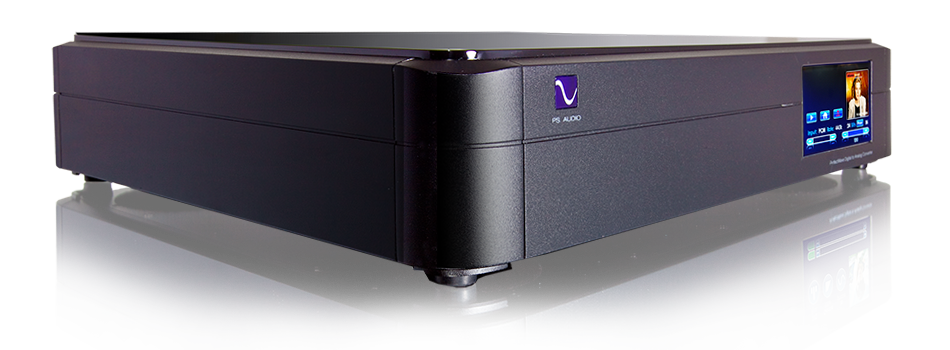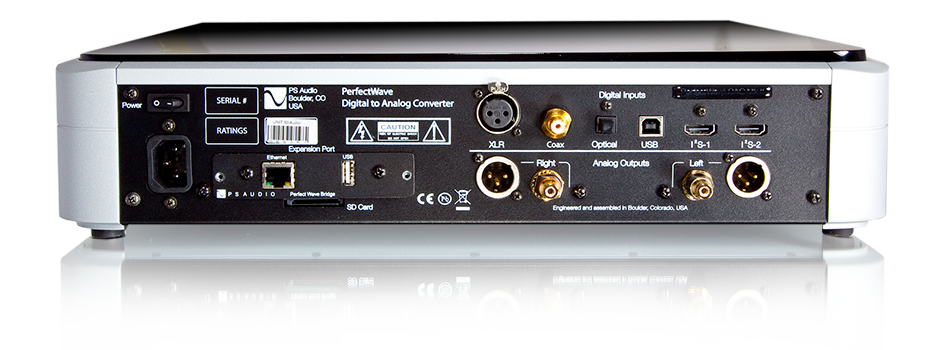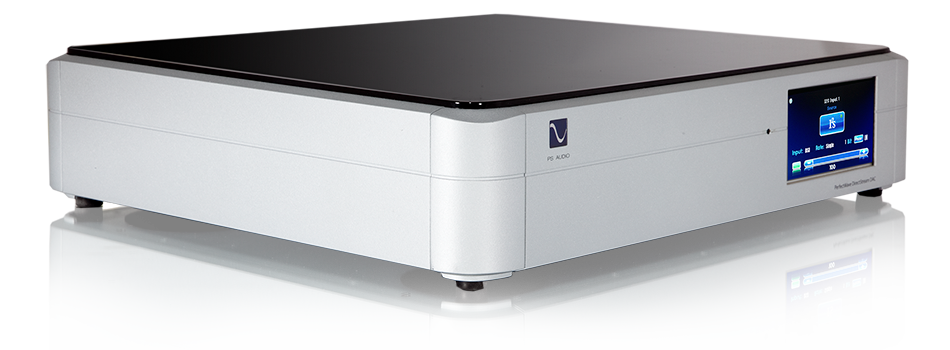As 2014 drew to a close, Headphone.Guru staff writers were each asked to nominate one product as a personal favorite during the calendar year. In a year that saw numerous new offerings in the realm of personal audio, I chose to nominate the new flagship DAC from PS Audio, a product that can be seen as only tangentially meaningful to the realm of headphone hi-fi. Why choose the PerfectWave Directstream? With a form factor too large to fit on a desktop, and a price tag too expensive for all but the most hardened audiophile, it’s not an obvious choice. But having lived with the DAC and witnessed its singular capabilities. And I knew that not only did I wish to nominate the Directstream as “product of the year”, I also wanted to follow up with this in-depth appraisal.
Sure, the publications and webzines have all opined, and a consensus has been formed – a glowing one at that. Awards and accolades have been thrown around like so many beads at Mardi Gras. “What more can be said about this device?” you might be asking.
“Plenty,” would be my response. With the Directstream, I would argue, there can really be no final word, only an ongoing conversation (one that will not likely be finished any time soon). This is because the Directstream is a DAC unlike others – it is instead a perpetually programmable audio decoding engine.
Perhaps I should explain…

AN AUDIO DECODING ENGINE
If 2014 is remembered for anything, it might be remembered as the year that DSD exploded onto the audio scene. DSD (Direct Stream Digital) was at one time confined to the Super Audio Compact Disc (SACD), but became a viable file format with the recent development of a new open standard for transferring its stream of bits to a DAC (DSD-over-PCM).
DSD’s sudden popularity was such that to introduce a high-end DAC in 2014 without DSD capability was to invite the scorn of the audiophile community. With the Directstream, PS Audio wanted to take things further – to produce a device that not only decoded DSD, but converted incoming PCM signals to DSD as well. Chief designer Ted Smith had long held that DSD was superior to PCM. His gut told him that this approach might reap some benefits even for standard resolution audio. His gut also told him that no off-the-shelf DAC chip was going to be up to the task.
Smith chose instead a field-programmable gate array, or FPGA. Unlike a conventional DAC chip, which has been factory-programmed for its function, an FPGA allows for a more open-ended use by being programmed after its manufacture. With careful programming, then, Smith could create a DAC that would up-sample all incoming signals, whether PCM or DSD, to a one-bit stream at 28.224 megahertz, or 10 times DSD.
When Smith settled on this FPGA, he knew it would give him full control over the technical reigns. What he may not have seen as plainly, though, was that it would allow for his continual tweaking of the programming language, by way of firmware updates, even after the product was shipped.
I have installed two such updates during my time with the Directstream. Each was a fairly simple and straightforward affair, not unlike a firmware update you’d perform on a Blu-ray player. But unlike a typical firmware upgrade, these were able to improve the technical performance of the DAC by a considerable margin.
This is a fascinating angle from which to examine the Directstream – as a powerful and open-ended machine, one that not only does what it was purchased to do, but holds the promise of more – more performance, more function. While I don’t wish to be too bold in the assertion, the days of the DAC as a fixed and immutable object may be in the rearview mirror. Perhaps PS Audio, along with Chord Electronics with their remarkable Hugo and Hugo TT, will be seen as the progenitors of this exciting movement.
So, how do things sound, here at the dawn of this new digital era? Well, since February 2014, and firmware version 1.2.1, things sound pretty darn remarkable.

A SNAPSHOT
When I nominated the Directstream as product of the year, I called the DAC “revealing without being ruthless, detailed without being clinical, precise without being lifeless.” I stand by those words, of course, but would add insightful to the mix.
Listening to Crowded House’s “Fall at Your Feet,” the PS Audio’s insightful presentation is on full display. Here is a track that has been a part of my consciousness since its release in 1991. And somehow, through the PS Audio, there are new layers of information that emerge, like a watermark on a piece of paper that shows up only when held up to the light. What were once massed vocals are now clearly the individual voices of Tim and Neil Finn, each with its own place carved out in the soundstage, each overdubbed “aaaah” now a lonesome cry. During the song’s stirring middle section, a vocalist comes in to shout the words along with the lead vocal. You can clearly hear how the shouting vocalist is backed away from the microphone, and how the shout energizes the space in which it was recorded. Suddenly the old and familiar is new again in the stunning light of the Directstream.
This light is a helpful analogy in understanding the Directstream. The DAC shines a light into the deepest recesses of the music. Most of the time, what it finds there are the sonic cues that lend a greater sense of space and realism to the performance. Other times, a previously unheard instrument may emerge. On more than a few occasions, I uttered the phrase “I’ve never heard that before.” Such is the Directstream’s ability to unravel even the most complex musical tapestry.
Revealing gear such as the Directstream can certainly be a joy, especially when the surrounding components are up to task. Add a top-notch set of cans and a headphone amplifier, and you will have one of the most detail-oriented rigs imaginable. Of course, one must bear in mind that a DAC cannot choose what it reveals about the recordings being played back. One might not wish to know, for example, that Rory Gallagher’s guitar amp was emitting a 60-cycle hum for pretty much an entire performance, or that one of the Beach Boys cleared his throat during the organ solo on “Wendy”. But through the PS Audio, such minutiae are dredged up nonetheless.
But more often than not, the PS Audio finds meaningful details, and presents them with the desired amount of musicality, without which the sound would be but a series separate elements that each arrest the ear, yet never emerge as a musical whole. There are DACs that commit this sin; the Directstream is not one of those.
Another strength of the Directstream is its utter lack of distortion and purity of tone, especially in the treble. In my experience, distortion artifacts usually show up first in the treble, making metallic percussion a tough feat for an audio system. The Directstream, though, is so deft in it’s handling of treble that it seems to lend a helping hand to any downstream gear. Have a set of headphones that are a bit treble-happy (say, an AKG K701)? The Directstream can rescue them from the storage bin. The DAC starts things off on such a crystalline note, treble that previously annoyed now has a more pleasing silvery shimmer.

In my first few weeks with the Directstream, the DAC impressed me so much that I wanted to hear it through all my speakers and headphones. Not only would moving the DAC around help me gain a greater understanding of its sonic character, it also turned out to be quite fun. Slotting the Directstream into my various rigs brought about new heights of performance from each. The PS Audio never drew attention to itself, though. Rather, I was more drawn to the music, which was more organic and lifelike through the PS Audio. Removing the DAC, that added detail and naturalness were sorely missed.
Indeed, my few months with the Directstream have been pure pleasure, and the DAC’s sonic performance has been almost without reproach. I say almost because, well, I do have one minor quibble. That is, the Directstream can come across as a touch laid-back, particularly in the bass. And by “a touch”, I mean there’s a degree of softness that might not be detected until compared with another source. Playing something like AC/DC’s “Girls Got Rhythm” through the PS Audio, and then through the Oppo BDP-105, the Sabre-chipped Blu-ray player brings a bit more punch to the hard-rocking number.
I also have a couple criticisms that don’t pertain to the sonics, and chief among those is the sheer size of the unit. Most personal hi-fi enthusiasts are looking for a Bruce Lee type device – compact yet powerful. The Directstream is more of an Arnold Schwarzenegger, at 17 inches wide and 31 pounds, making it nigh-on impossible for a desktop system. It almost needn’t be said that there are smaller DACs out there. I can think of a few nice ones that get the job done in half the footprint, and may be better candidates for the headphone enthusiast looking for a compact rig. But, Paul McGowan was insistent on using the casework from the previous PerfectWave, allowing owners of those earlier generation DACs to upgrade the innards. And I applaud Paul’s approach for that reason. The casework is quite nice, after all, and well-appointed to its purpose; and the textured finish is excellent. Sure, I might wish for something other than the mirror-finished MDF top plate. I’ve been compulsively dusting that darn thing every other day.
My second criticism is the analog output method of the device. To achieve the most signal purity, a passive, transformer-based analog output was employed. However, this elegant solution comes with a price: Only one set of analog outputs can be used at a time (without inviting unnecessary signal degradation). For those hoping to connect both a single-ended amp and a balanced amp to this device, here is a strike against the Directstream. (And I have a sneaking suspicion this passive output is at least partly responsible for the Directstream’s somewhat polite bass.)
And my final criticism is one that may seem at odds with designer Ted Smith’s principle goals for the product. That is, the Directstream is only as good as the transport being used. While this shouldn’t be so (Smith designed the Directstream to be as indifferent to source as possible), my ears cannot help but discern differences among the digital sources tethered to the device. My MacBook Pro running Audirvana+ delivers music that is airy and spacious, but tilted to the cooler end of the spectrum. My Windows 8 laptop running JRiver gives a denser and darker presentation, but one that lacks a bit of refinement in the highs. And my Auralic Aries? Well, it sounds downright fabulous when playing back files from a USB hard drive, but slightly less so when streaming over Wi-Fi, and then again less resolving when playing back lossless music from a streaming service such as Tidal. While the Directstream purportedly deconstructs the incoming bit stream, thus nullifying any mistakes made by the transport, I am almost baffled by what I hear – that the quality and character of sound is ultimately influenced by the transport attached (and for that matter, even the cable between them).
I level this criticism at the PS Audio only because the DAC was touted as a horse of a different color – a source-agnostic DAC. What I hear instead has turned me into something of a Goldilocks, on a restless search for the perfect transport. But, who knows? With a firmware update the DAC may prove more indifferent to the transport being used. Heck, Ted Smith could even pack a bit more bass punch into the machine while he’s at it.
Listening to music through the Directstream, though, all my minor quibbles fade to the background. The sound is, quite simply, the best I have heard in my home, and among the best digital reproduction of music that I have heard at any price. When I think about what PS Audio does, and can do, the $5995 price tag doesn’t seem so objectionable.
Sure, it’s an overly-large DAC, and was built first and foremost for two-channel enthusiasts. Some of its features will be lost on the headphone crowd (such as its lossless volume control, allowing for direct connection to a power amplifier, or its well-designed remote control). However, if the price, size, and few functional quirks mentioned are not a deterrent, the Directstream is certainly worthy of an audition. It is truly an exceptional product, and a DAC that allows even the most familiar music to surprise and enthrall.
Yes, the folks at PS Audio understand that with digital audio, there can be no final word. Meet the Directstream – a DAC that is ready to keep up with the conversation.















Reply
Reply
Want to join discussion?
Feel free to contribute!